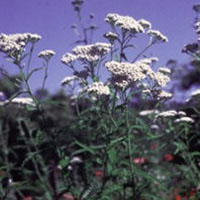Search Healthnotes
Yarrow
 © Steven Foster
© Steven FosterHow It Works
A number of chemicals may contribute to yarrow’s actions. The volatile oil, which is rich in sesquiterpene lactones, and alkamides has been found to have anti-inflammatory properties in test tube studies.3, 4 Animal studies have shown this herb can reduce smooth muscle spasms, which might further explain its usefulness in gastrointestinal conditions.5 The alkaloid obtained from yarrow, known as achilletin, reportedly stops bleeding in animals.6 No human clinical studies have confirmed the traditional uses of yarrow.
How to Use It
The German Commission E monograph suggests approximately 1 teaspoon (4.5 grams) of yarrow daily or 3 teaspoons (15 ml) of the fresh pressed juice.7 A tea can be prepared by steeping 1–2 teaspoons (5–10 grams) of yarrow in 1 cup (250 ml) boiling water for ten to fifteen minutes. Three cups (750 ml) a day can be taken. A tincture, 1/2–3/4 teaspoon (3–4 ml) three times per day, can be taken. The tea, or cloths dipped in the tea, can be used topically as needed for minor skin injuries.
Copyright © 2024 TraceGains, Inc. All rights reserved.
Learn more about TraceGains, the company.
The information presented by TraceGains is for informational purposes only. It is based on scientific studies (human, animal, or in vitro), clinical experience, or traditional usage as cited in each article. The results reported may not necessarily occur in all individuals. Self-treatment is not recommended for life-threatening conditions that require medical treatment under a doctor's care. For many of the conditions discussed, treatment with prescription or over the counter medication is also available. Consult your doctor, practitioner, and/or pharmacist for any health problem and before using any supplements or before making any changes in prescribed medications. Information expires December 2024.











